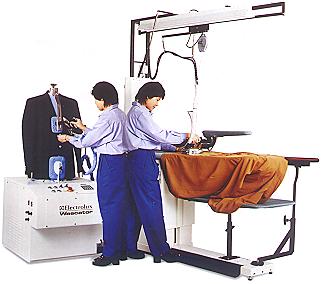I worked in a drycleaners when I was in college. It is called dry cleaning because it does not use water not because no liquids are used. The clothes are first checked for stains or problem areas and are pretreated for these.
A typical wash cycle lasts for 8-minutes depending on the type of garments and amount of soiling. During the first three minutes, solvent-soluble soils dissolve into the perchloroethylene and loose insoluble soil from fabrics comes off.

Organic solvents are used instead of water. What is used has varied over the years: A Brief History drycleaning dates back to ancient times, probably beginning with the advent of textile clothing itself. The ruins of Pompeii gives a record. Dry cleaning , on the other han is different. These molecules interact with stains without affecting the fibers.
As with washing in water, mechanical agitation and friction lift the stains away from the fabric, so they are removed with the solvent. As a result of this innovation, the majority of clothes today are cleaned by perc. A proliferation of cleaning franchises and dry-cleaning businesses offering fast service from convenient, clean , and attractive locations evolved to change the industry into what we see today.
Once you know how dry cleaning works , it’s really not that crazy of a process. We still aren’t sure why they call it dry cleaning in the first place, but hey. Technically it doesn’t use any water. Hope this helped to clear things up and as always, thanks for reading!
Until next time, friends. We know that our clothes come back a whole lot cleaner than when we dropped them off, but how? The modern dry cleaning process was developed and patented by Thomas L. Tetrachloroethylene, which the industry calls perc, is the most widely used solvent. Alternative solvents are trichloroethane and petroleum spirits. What is the process for dry cleaning and how does it work?
Are you supposed to tip the dry cleaners? How safe is dry cleaning? In dry cleaning , a petroleum solvent is used instead of water. It is dry only in the sense that it is not wet with water. In the early days of dry cleaning , this solvent was often kerosene or gasoline.
Today the industry uses a solvent called perchloroethylene almost universally.
Post-spotting - Any lingering stains are removed. Finishing - This includes pressing, folding, packaging and other finishing touches. The following sections look at each of these steps in detail.
The question is, how does it actually work ? Short Answer: Rather than using water, dry cleaning relies on a different non-water-based solvent to remove stains, followed by additional processing and pressing to keep delicate clothes looking brand new. They are then placed into a large machine, rather like a large washing machine. The clothes spin in the machine, which also administers up to 2gallons (75liters) of perc in as little as eight minutes, the typical cycle length. The process of dry cleaning resembles the steps when using washing machines but on a larger scale.
Clothes are loaded into a commercial dry cleaner that uses solvents to remove dirt and stains. The solvent is extracted during the process and then recycled for another use. It works like this: When you drop a collared shirt or Pendelton throw off at the dry cleaners, both are tossed in a machine that looks and acts kind of like an over-sized front-load washer.
No comments:
Post a Comment
Note: only a member of this blog may post a comment.